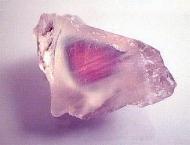Sunstone: Difference between revisions
m Reverted edits by 65.95.149.111 (talk) to last version by Idioma-bot |
Added Template |
||
| Line 24: | Line 24: | ||
{{1911}} |
{{1911}} |
||
{{Gems & Crystals}} |
|||
[[Category:Silicate minerals]] |
[[Category:Silicate minerals]] |
||
Revision as of 05:05, 23 April 2007
- See also: Nauvoo Temple for an article including information on the Latter-day Saint motif known as a Sunstone, and Sunstone Magazine for the magazine of that name which deals with Latter-day Saint topics.


Sunstone, a feldspar exhibiting in certain directions a brilliant spangled appearance, which has led to its use as an ornamental stone.
The effect appears to be due to reflections from enclosures of red haematite, in the form of minute scales, which are hexagonal, rhombic or irregular in shape, and are disposed parallel to the principal cleavage-plane. These enclosures give the stone an appearance something like that of aventurine, whence sunstone is known also as "aventurine-feldspar."
Sunstone is not common, the best-known locality being Tvedestrand, near Arendal, in south Norway, where masses of the sunstone occur embedded in a vein of quartz running through gneiss. It is found also near Lake Baikal, in Siberia, and at several localities in the United States, notably at Middletown Township, Delaware County, Pennsylvania, and at Statesville in North Carolina.
The feldspar which usually displays the aventurine appearance is oligoclase, but the effect is sometimes seen also in orthoclase: hence two kinds of sunstone are distinguished as "oligoclase sunstone" and "orthoclase sunstone." The latter has been found near Crownpoint and at several other localities in the state of New York, as also at Glen Riddle in Delaware County, Pennsylvania, and at Amelia Court House, Amelia County, Virginia.
A variety known as Oregon sunstone is found in Lake and Harney Counties, Oregon. Sunstone is also found in Pleistocene basalt flows at Sunstone Knoll in Millard County, Utah.
It has been speculated that the Vikings used sunstone's light-polarising property to tell the direction of the sun on cloudy days, for navigational purposes. This sunstone is Optical calcite, (CaCO3), also known as Iceland Spar, found in Iceland at several locations.
[1][2] In 2007, Gabor Horvath from Eotvos Lorand University in Budapest (Hungary) confirmed that the polarisation of sunlight in the Arctic can be detected using a sunstone.[3]
References
- ^ The Viking Sunstone, from Polarization.net. Retrieved February 8, 2007.
- ^ Secrets of the Viking Navigators, by Leif K. Karlsen. One Earth Press, 2003. ISBN 978-0972151504
- ^ Crystals "helped Viking sailors", BBC News. Retrieved February 8, 2007.
This article incorporates text from a publication now in the public domain: Chisholm, Hugh, ed. (1911). Encyclopædia Britannica (11th ed.). Cambridge University Press. {{cite encyclopedia}}: Missing or empty |title= (help)
Template:Gems & Crystals
